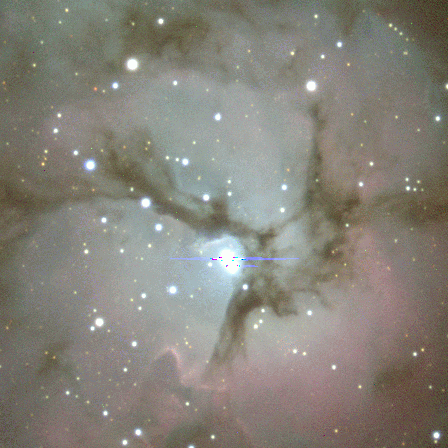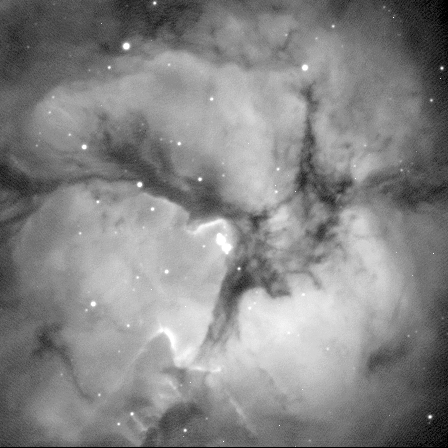

The emission nebula, or H II region, Messier 20 (NGC 6514) in Sagittarius, shown from a color composite of B, V, and R exposure (30 to 60 seconds) with a Tektronix 2048x2048 CCD at the 2.1-meter telescope of Kitt Peak National Observatory by Bill Keel and Lisa Frattare. North is at the top and east to the left, for direct comparison with a chart or eyepiece view. The image has been block-averaged by a factor of two for this presentation (and another factor of two as shown above), which uses a logarithmic intensity transformation to preserve information across a wide dynamic range. The field is 9.1 arcminutes square, which doesn't quite encompass the bright ionized gas region and misses the reflection nebula on the north side entirely.
The colors betray a mix of conditions, and in places a mix of reflected starlight and emission from ionized gas. Many stars appear heavily reddened, another sign of the extensive dust cloud associated with the whole star-forming region. The bright central ionizing star was saturated, causing the horizontal bleeding across the detector which is especially apparent in the blue frame.An H-alpha image, shown in grayscale below, shows even more intricate detail, including the "horns" which were prominent in a closeup HST view. These structures may result from the energy output of the brightest massive stars destroying the molecular gas surrounding less massive stars which were still forming, depriving them of further material and laying bare their dense surroundings.

Wider perspective is seen in this image from g and r filters made with the UA Crimson Dragon wide-field system deployed to Kitt Peak. This view runs from the Lagoon Nebula at the bottom to the Trifid Nebula at the top edge, and the intricate dust lanes throughout this area of sky.

Last changes: 9/2018 © 2001-2018